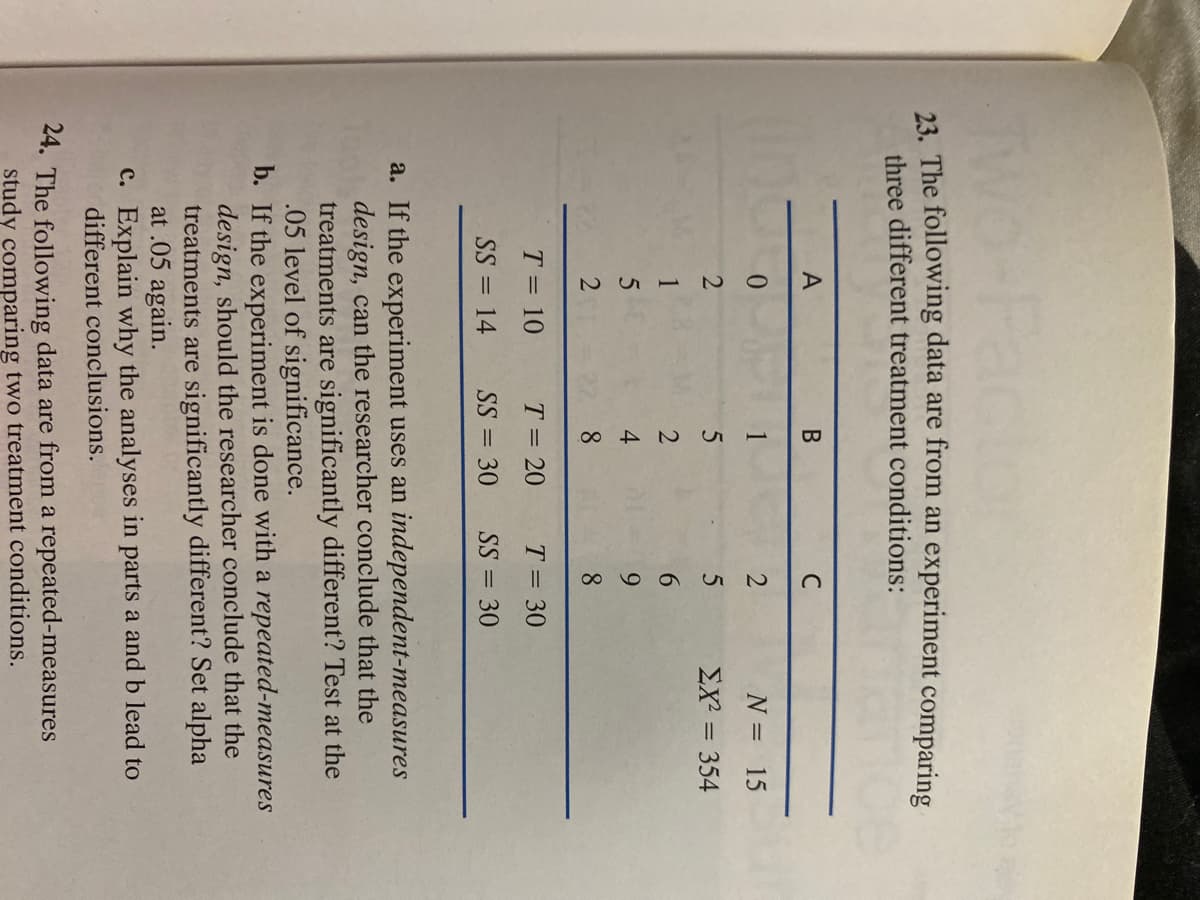23. The following data are from an experiment comparing three different treatment conditions: C 2 N = 15 5 ΣΧ354 %3D 6. 9. 8. 8. T = 10 T = 20 T = 30 SS = 14 SS = 30 SS 30 a. If the experiment uses an independent-measures design, can the researcher conclude that the treatments are significantly different? Test at the .05 level of significance. b. If the experiment is done with a repeated-measures design, should the researcher conclude that the treatments are significantly different? Set alpha at .05 again. c. Explain why the analyses in parts a and b lead to different conclusions.
23. The following data are from an experiment comparing three different treatment conditions: C 2 N = 15 5 ΣΧ354 %3D 6. 9. 8. 8. T = 10 T = 20 T = 30 SS = 14 SS = 30 SS 30 a. If the experiment uses an independent-measures design, can the researcher conclude that the treatments are significantly different? Test at the .05 level of significance. b. If the experiment is done with a repeated-measures design, should the researcher conclude that the treatments are significantly different? Set alpha at .05 again. c. Explain why the analyses in parts a and b lead to different conclusions.
MATLAB: An Introduction with Applications
6th Edition
ISBN:9781119256830
Author:Amos Gilat
Publisher:Amos Gilat
Chapter1: Starting With Matlab
Section: Chapter Questions
Problem 1P
Related questions
Question

Transcribed Image Text:Two-Fa
23. The following data are from an experiment comparing
three different treatment conditions:
A
1
N = 15
2
5
ΣΧΧ-354
1
6.
9.
8
8
T = 10
T = 20
T = 30
SS = 14
SS = 30
SS = 30
%3D
a. If the experiment uses an independent-measures
design, can the researcher conclude that the
treatments are significantly different? Test at the
.05 level of significance.
b. If the experiment is done with a repeated-measures
design, should the researcher conclude that the
treatments are significantly different? Set alpha
at .05 again.
c. Explain why the analyses in parts a and b lead to
different conclusions.
24. The following data are from a repeated-measures
study comparing two treatment conditions.
Expert Solution
This question has been solved!
Explore an expertly crafted, step-by-step solution for a thorough understanding of key concepts.
This is a popular solution!
Trending now
This is a popular solution!
Step by step
Solved in 5 steps with 1 images

Knowledge Booster
Learn more about
Need a deep-dive on the concept behind this application? Look no further. Learn more about this topic, statistics and related others by exploring similar questions and additional content below.Recommended textbooks for you

MATLAB: An Introduction with Applications
Statistics
ISBN:
9781119256830
Author:
Amos Gilat
Publisher:
John Wiley & Sons Inc

Probability and Statistics for Engineering and th…
Statistics
ISBN:
9781305251809
Author:
Jay L. Devore
Publisher:
Cengage Learning

Statistics for The Behavioral Sciences (MindTap C…
Statistics
ISBN:
9781305504912
Author:
Frederick J Gravetter, Larry B. Wallnau
Publisher:
Cengage Learning

MATLAB: An Introduction with Applications
Statistics
ISBN:
9781119256830
Author:
Amos Gilat
Publisher:
John Wiley & Sons Inc

Probability and Statistics for Engineering and th…
Statistics
ISBN:
9781305251809
Author:
Jay L. Devore
Publisher:
Cengage Learning

Statistics for The Behavioral Sciences (MindTap C…
Statistics
ISBN:
9781305504912
Author:
Frederick J Gravetter, Larry B. Wallnau
Publisher:
Cengage Learning

Elementary Statistics: Picturing the World (7th E…
Statistics
ISBN:
9780134683416
Author:
Ron Larson, Betsy Farber
Publisher:
PEARSON

The Basic Practice of Statistics
Statistics
ISBN:
9781319042578
Author:
David S. Moore, William I. Notz, Michael A. Fligner
Publisher:
W. H. Freeman

Introduction to the Practice of Statistics
Statistics
ISBN:
9781319013387
Author:
David S. Moore, George P. McCabe, Bruce A. Craig
Publisher:
W. H. Freeman